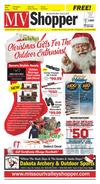100317_YKMV_A12.pdf






October 3, 2017 • Page 12
shop online at www.missourivalleyshopper.com
Hunting
Guide
2017
If you are one of the hundreds of thousands of hunters who take to the woods in
pursuit of whitetail deer this
fall, take a few minutes to
review some basic safety information from Whitetails
Unlimited that will insure
that everyone enjoys the
hunt safely.
• Handle all firearms as
if they were loaded, at all
times. Every year there are
news stories of accidents
where someone thought
they were handling an unloaded firearm, and it fires
and injuries or kills someone. If you always consider
a weapon to be loaded, and
it it accordingly, this won’t
happen.
• Watch where you point
the muzzle of every firearm.
this takes diligence and
awareness, but it is a skill
that be quickly developed.
Always be aware of where
other people are in relation
to your muzzle, and let your
hunting partners know if
they are not being as careful
as you are. It is easy to lose
concentration when every-
Hunt Smart, Hunt Safe
one is uncasing their guns
at the back the the pickup,
or when you are tired at the
end of the day. Always point
the muzzle in a safe direction.
• Don’t rely on your firearm’s safety. A safety is a mechanical device, and it could
fail at any time. Use it religiously except when you are
ready to fire, but never assume that because the safety
is on, you are 100 percent
safe. Unload the firearm
when not in use, and leave
the action open, if possible.
Also, after you shoot, put
the safety on before you take
your first step.
• Be sure of your target,
and what is in front and behind your target. It is easy
to get excited when you see
that big buck, but first make
sure that is really a deer, and
if it is safe to shoot. Make
sure there are no buildings,
people or roads behind the
deer that would be in danger if you miss or the bullet
passes through the animal.
If you are not 100 percent
sure of where your hunting
companions are, or if there
isn’t enough light or a clear
sight line to the target, pass
p on the shot. You will get
another chance at a deer, but
sending a bullet out of your
barrel without being sure of
your target and background
is an invitation to disaster.
• Take care of your firearms and ammunition, and
treat them with respect.
Don’t just grab a gun and
some ammo that have been
stored for months as you
leave the house the morning
of your hunt. Spend some
time to make sure your
equipment is in good shape.
Take it out before the hunt
to check the sights or scope.
Make sure the barrel is not
obstructed and that the action works properly.
• Make sure the ammunition matches the firearm. Never horseplay with
firearms and never climb
a fence, ladder, tree or tree
stand, or cross difficult or
slippery terrain with a loaded firearm. Also remember
that you can set the example
for everyone in your group,
especially for younger hunters.
• Be safe if you are using a tree stand. Never
climb into the stand carrying your weapon. Unload
your weapon and use a line
to pull your gun or bow up
after you have fastened your
safety harness (remember to
reload after you are settled).
Reverse the process when
you leave the tree stand.
Always unload the weapon,
and always use a safety harness or belt.
• Control your emotions. After you shoot that
10-pointer, don’t turn with
your loaded firearm, with
the safety off, toward your
friends. Don’t run to the
downed animal, or chase
off into someone else’s firing
lane. Rehearse in your mind
what safe actions will be,
and always be aware of your
surroundings. Show some
discipline and restraint, and
don’t take poor shots that
may be unsafe.
• Be aware of any other
circumstances that may affect safety. If the landowner
tells you to stay out of an
area, respect his directions,
rain, fog, snow or sleet may
reduce visibility or create
hazardous conditions. Use
common sense, and remember that a tragic accident
can be the result of taking
chances.
• Never mix alcohol or
drugs with firearms. The
first drink of the day is the
end of the hunting day, no
matter what time it is. Forget the eye-opener, the flask
“to keep you warm,” or the
pick-me-up with lunch, and
don’t tolerate drinking (or
drugs) from anyone you
hunt or shoot with. Alcohol and guns are a deadly
combination. Before you
have that beer with dinner
at night, make sure all firearms are already unloaded,
cleaned and cased. In addition, if you are taking any
prescription or over-thecounter medications that
may affect your judgement,
or make you drowsy, anxious or otherwise impaired,
check with your doctor or
pharmacist to see if there is
an alternative.
• Safety does not end
when you leave the woods.
Even if you are tired, cold,
and hungry when you get
home, safety is still the first
priority. Before anything
else, store your firearms and
ammunition in a safe place,
separate form each other
and out of the reach of children. Then call your friends
to come see your deer, take a
hot shower and get a decent
meal. You’ve earned it.
Remember that hunting is a process, not a destination. No deer is worth
risking your or someone
else’s life. There are friends,
family and other people in
the woods with you, and a
successful hunt is not really measured in points and
pounds, but in fellowship
and appreciation of our natural world.
vArticle Courtesy of Whitetails Unlimited
Good Earth State Park Receives National Recognition
For Cultural and Historical Significance
Sioux Falls, S.D. -The National Association of State
Park Directors formally
recognized and awarded
Good Earth State Park as
this year’s recipient of the
Ney Landrum Park History
Award.
"On behalf of our team at
Good Earth State Park and
our entire department, we
are grateful to be receiving
the Ney Landrum Park History Award this year," stated
Katie Ceroll, director of the
division of parks and recreation. "The park and the
brand new visitor center re-
flect the team’s collaboration
in research and presentation
of this site’s history, which
has allowed the historical
and cultural preservation of
the area to come to life for
current and future generations."
The park preserves a portion of a larger historically
and culturally significant
site referred to as Blood
Run, which is a designated
National Historic Landmark. The location is the
largest known Oneota (tribal) habitation discovered to
date. As many as 10,000 in-
digenous people occupied
it at its peak, from 1500 to
the early 1700s, with villages
stretched over four miles
along the Big Sioux River in
what is now Iowa and South
Dakota.
Descendants now make
up four different tribes, Ioway, Otoe, Ponca and Omaha, located in several states.
Honoring the site’s history, required collaboration and input from tribal
people. The Good Earth
team conducted interviews,
researched legends and
stories, analyzed artifacts,
located family heirlooms,
learned traditions and languages, and conducted focus groups. Tribal historic
preservation officers, tribal
elders and other members
of the descendant tribes
provided information and
oversight for accuracy.
The park includes over
six miles of hiking trails and
three viewing platforms. Future plans include a 200-person outdoor amphitheater
and a pedestrian bridge over
the Big Sioux River, connecting Good Earth to areas
of Blood Run managed by
Game Meat Donations Increased Again
Donation of game meat
to families in need increased
again in 2016 with a modest increase in donations
by hunters and significant
increase in meat donation
through the Sportsmen
Against Hunger (SAH) salvage processing program.
Deer hunters continued
to show interest in, and play
an important part in, donation of game meat through
SAH to food pantries across
the state. Total harvested
deer which were donated increased from 348 in 2015 to
397 in 2016. These numbers
included 256 antlerless deer
in 2016 compared with 204
antlerless deer in 2015. The
antlerless deer were donated
through the SAH processing
certificate program in which
a processing certificate completed and submitted by the
hunter to a participating
SAH game processor paid
for most or all of the processing cost.
The SAH salvage processing program has always
been an important program
in that funding has been
available to pay for processing of salvageable game carcasses provided by the South
Dakota Department of
Game, Fish and Parks (GFP)
and other game management agencies. This game
has included road-kills, confiscated game, euthanized
research animals, culled ani-
mals from a National Wildlife Refuge, and animals
taken in city deer reduction
programs.
The amount of processed
salvaged game meat received a huge boost this past
winter when Wind Cave
National Park conducted an
elk herd reduction program
from which harvested elk
were processed and the meat
provided to food pantries
and other charitable food
distributors affiliated with
Feeding South Dakota. SAH
was one of several funding
partners which paid for processing of these salvaged elk.
Sportsmen and sportswomen also donated a variety of other types of game
this past year including 7 antelope, 1,895 Canada geese,
1,831 pheasants, 1 buffalo
and 237 walleyes. The total
amount of processed donated game and fish meat provided to food pantries from
all sources, including game
meat food drives, increased
from 31,512 pounds in 2015
to 48,174 pounds in 2016,
and this meat was made
available to families in need
throughout the state..
In addition to recognizing
those individuals and wildlife management agencies
who donated game animals
and fish, credit needs to be
given to those hunters who
donated considerable cash
to SAH through the GFP li-
cense application check-off
system. SAH would also like
to acknowledge the corporations, foundations, organizations, and government
entities who also provided
funding to SAH for the primary purpose of paying for
processing of certain donated game. The large variety
and amount of support for
SAH translates into muchappreciated game meat for
families in need.
vBy Ron Fowler,
Sportsmen Against Hunger
Iowa.
The land acquisitions
that make up the park and
the facility were funded by
state dollars and $8 million
in private donations raised
by the South Dakota Parks
and Wildlife Foundation.
About the Ney Landrum
Park History Award: Ney
Landrum was the director of
the Florida State Parks from
1969 (when it became the
Division of Recreation and
Parks within Department of
Natural Resources) to 1989.
Before that, he was in charge
of the Outdoor Recrea-
tion Development Council.
He was a major influence
on the national state park
movement, and was director of the National Association of State Park Directors
for several years. The award
honors an individual or
team that has displayed outstanding efforts in original
research and presentation
of state park history that
results in a tangible work
product.
vSouth Dakota Game, Fish and Parks
www.missourivalleyshopper.com
ATTENTION HUNTERS
See Us For Your Wild Game Processing
Products available from
your fresh game:
•Salami
•Cheese Salami
•Smoked Country
•Ring Bologna
•Wieners
•Cheese Sticks
•Breakfast Sausage
•Bratwurst
•Cheesy Brats
•Jerky
•Sticks
•Dried Deer
Steiner’s Locker
404 E. 3rd St,. Yankton, SD • 605-665-3407
Swanson
Hunting Acres
“Where Good People Meet For Good Hunting”
Pheasant Hunts & Lodging
“Specializing in managing and developing fish and wildlife populations
and their habitats and providing land management services so you can
get the most enjoyment and profitability out of your property.”
•Wildlife Management •Fisheries Management •Land Management
•Habitat Management •Pond Management
•Serving much of the upper midwest
Brett Kleinschmit – 605-660-6566
brett antelopecreek@live.com • www.antelopecreekwp.com
Reservations or Information Call:
Jim, Darrel & Betty Swanson
89054 519th Ave., Niobrara, NE 68760
402-857-3794 or 402-841-7926
Lodging Year Round
2300 Acre Hunting Ground
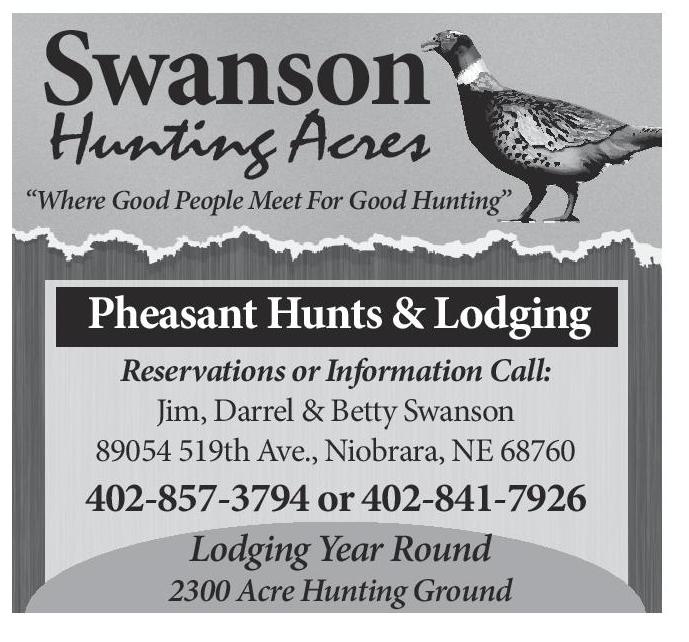

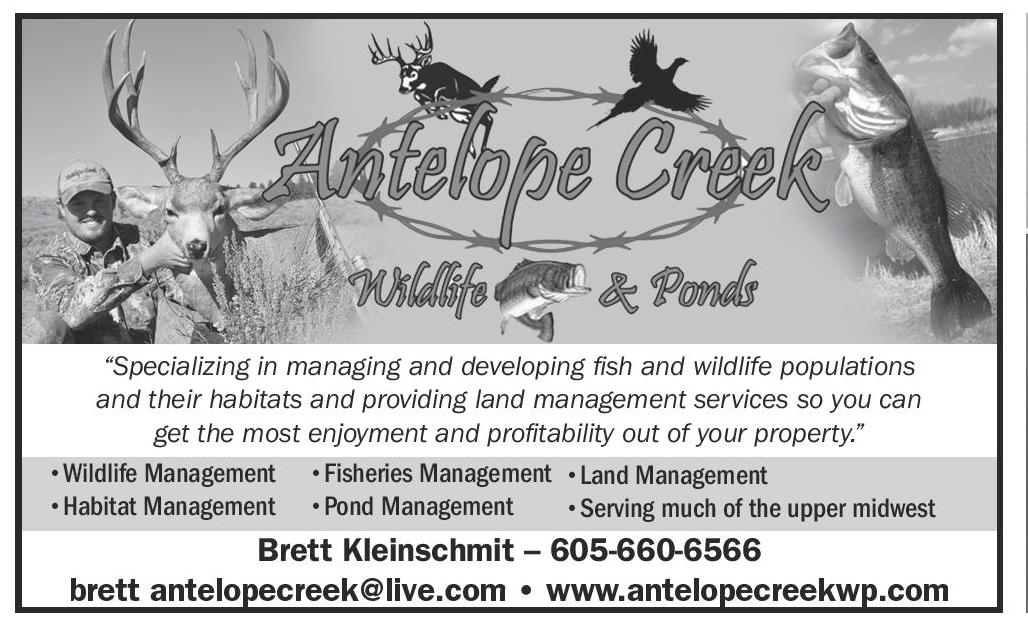
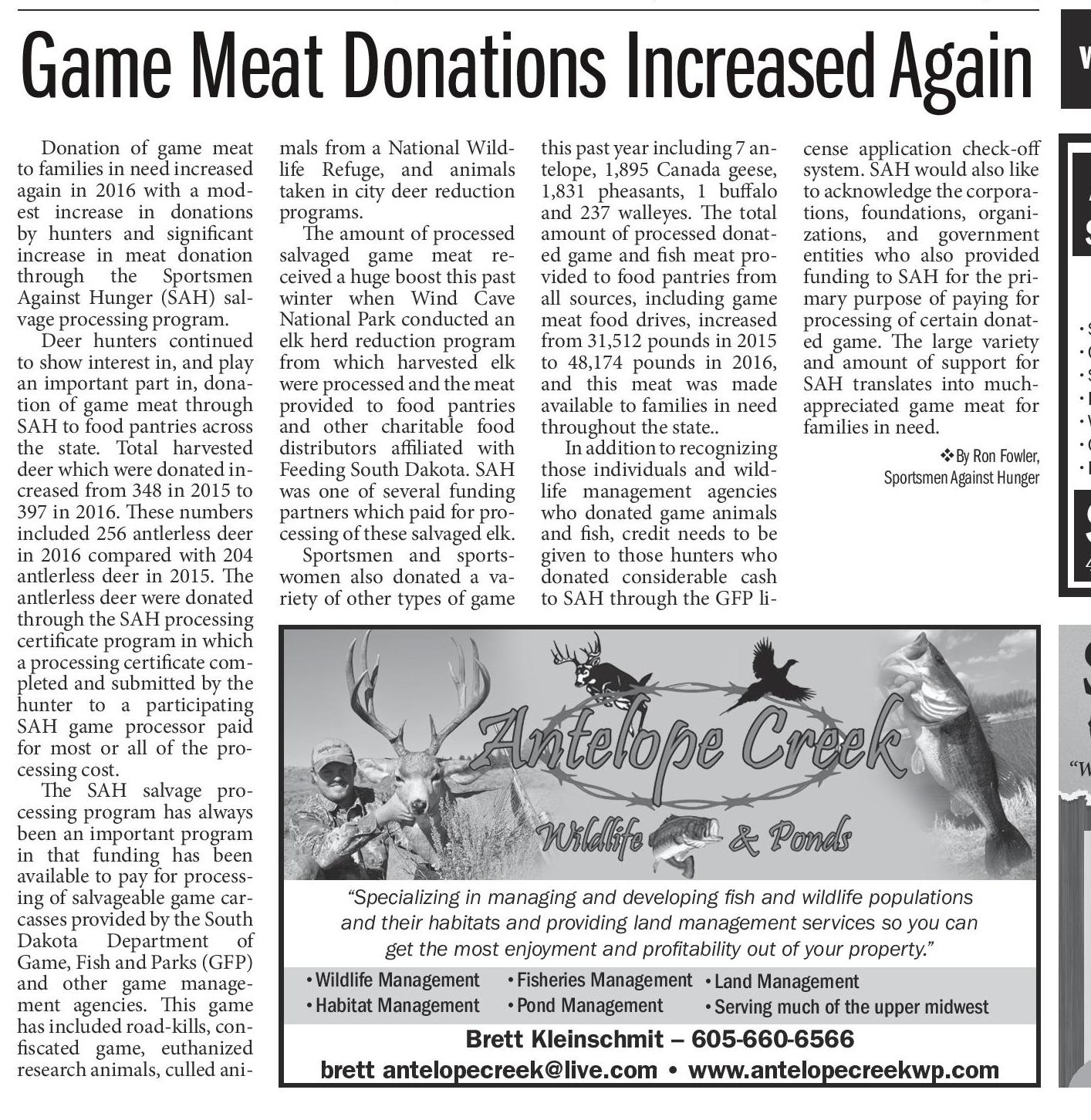

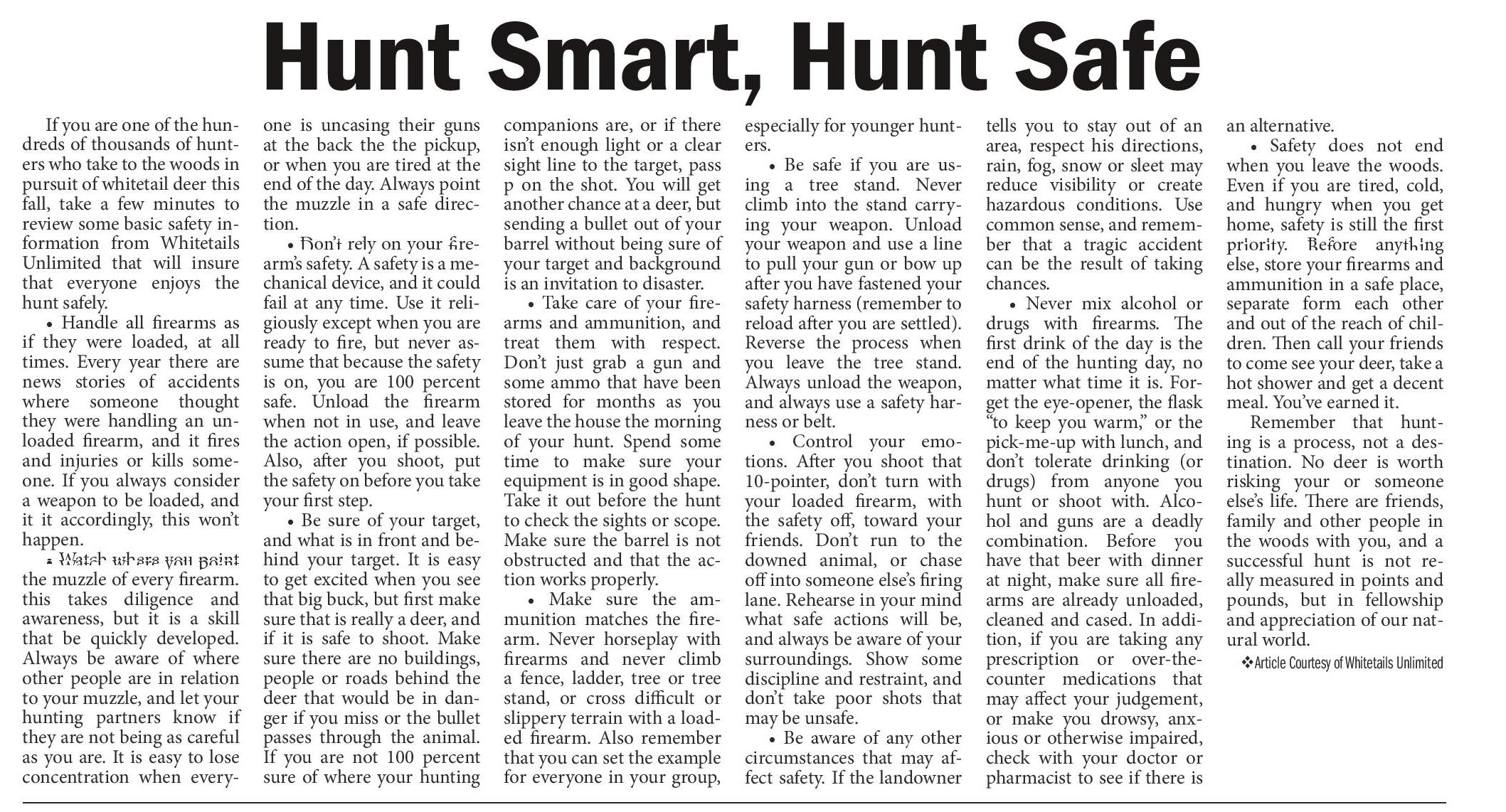

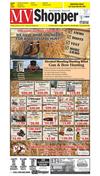

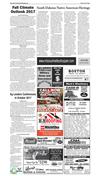
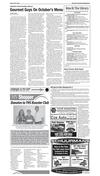


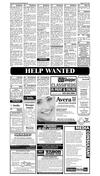
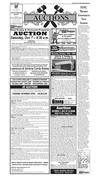
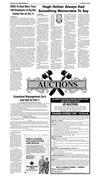
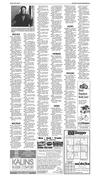



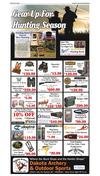
 Previous Page
Previous Page




